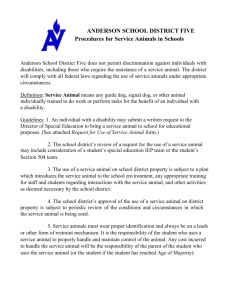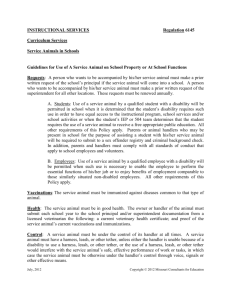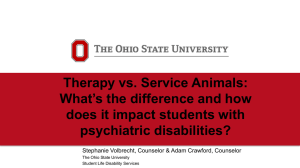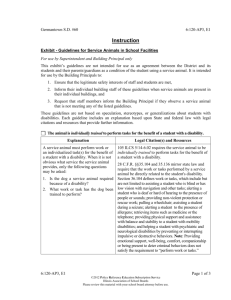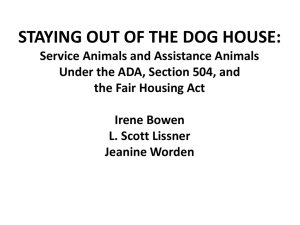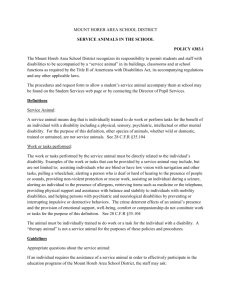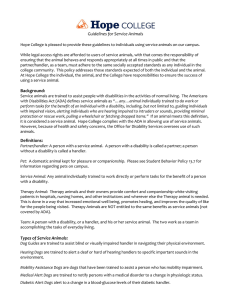SERVICE ANIMALS
advertisement
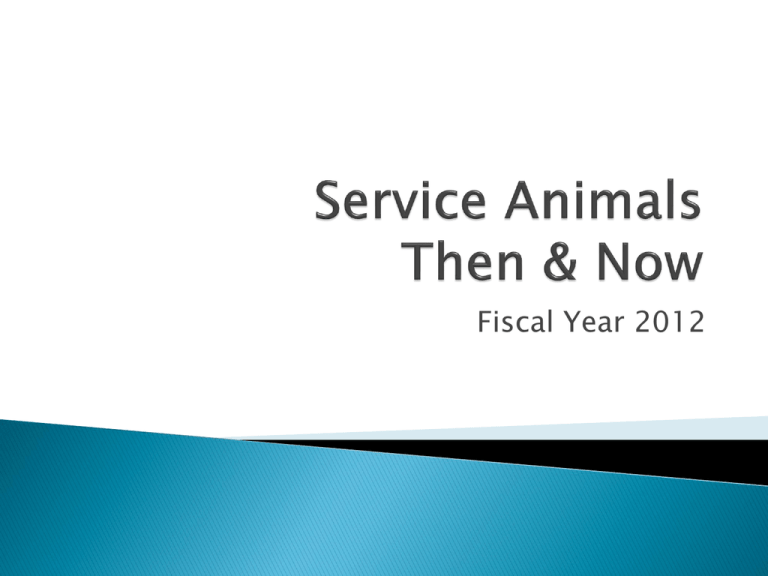
Fiscal Year 2012 It’s all about DOGS!!! What questions can/can’t be asked & what boundaries can be set? What about miniature horses? What about other animals? Are housing or airplane laws different? 2 1. Only dogs will be recognized as service animals. 2. Service animals are required to be leashed or harnessed except when performing work or tasks where such tethering would interfere with the dog's ability to perform. 3. Service animals are exempt from breed bans as well as size and weight limitations. 4. Businesses are generally required to accommodate the use of miniature horses under specific conditions, though they are not considered service animals. Effective March 15, 2011, “Service animal means any dog that is individually trained to do work or perform tasks for the benefit of an individual with a disability, including a physical, sensory, psychiatric, intellectual, or other mental disability. Other species of animals, whether wild or domestic, trained or untrained, are not service animals for the purposes of this definition. The work or tasks performed by a service animal must be directly related to the handler’s disability. Tasks can be for people with physical, sensory, psychiatric, intellectual, or mental disabilities. Assist during seizure. Retrieve medicine or other items. Help individual with dissociative identity disorder to remain grounded. Prevent/interrupt impulsive or destructive behavior. Assist with balance, stability. Provide non-violent protection or rescue work. 5 Only two permissible inquiries: Is this a service animal required because of disability? What work or tasks is the animal trained to perform? 6 Can’t ask about disability. Can’t request documentation (no formal training or certification required). Can’t ask for additional payment (no surcharges). Can’t exclude from most healthcare settings (except operating rooms and burn units). Dogs whose sole function is “the provision of emotional support, well-being, comfort, or companionship” are not considered service dogs under the ADA. The use of service dogs for psychiatric and neurological disabilities is explicitly protected under the ADA. “The crime deterrent effects of an animal's presence” do not qualify that animal as a service animal and “an animal individually trained to provide aggressive protection, such as an attack dog, is not appropriately considered a service animal.” Public accommodations/entities still required to allow handler even if animal is excluded. 8 Unless the animal is individually trained to do something that qualifies as work or a task, the animal is a pet or support animal and does not qualify for coverage as a service animal. A pet or support animal may discern that the handler is in distress, but it is what the animal is trained to do in response to this awareness that distinguishes a service animal from an observant pet or support animal. DOJ states “that an animal that is trained to ‘ground’ a person with a psychiatric disorder does work or performs a task that would qualify it as a service animal as compared to an untrained emotional support animal whose presence affects a person’s disability. It is the fact that the animal is trained to respond to the individual’s needs that distinguishes an animal as a service animal. “ According to the DOJ, “the process must have two steps: Recognition and response. If a service animal senses that a person is about to have a psychiatric episode and it is trained to respond, for example, by nudging, barking, or removing the individual to a safe location until the episode subsides, then the animal has indeed performed a task or done work on behalf of the individual with the disability, as opposed to merely sensing an event.” Tasks performed by psychiatric service animals may include reminding the handler to take medicine, providing safety checks or room searches for persons with PTSD, interrupting self-mutilation, and removing disoriented individuals from dangerous situations. Remember the difference between an emotional support animal and a psychiatric service animal is the work or tasks that the animal performs. The animal is out of control and the animal´s handler does not take effective action to control it, or The animal is not housebroken. Public accommodation/entity is not responsible for care or supervision of a service animal. 11 Allowed if: Reasonable Individually trained Make reasonable modifications to permit if appropriate 12 Use assessment factors: Type, size, weight (whether facility can accommodate) Handler’s control Whether housebroken Legitimate safety requirements of specific facility 13 Many service animal provisions also apply: Admit individual without animal Care and supervision No surcharges Other laws may apply 14 DOJ “has decided to make clear that all wild animals, whether born or bred in captivity or in the wild, are eliminated from coverage as service animals.” DOJ “believes that this approach reduces risks to health or safety attendant with wild animals. Some animals, such as certain non-human primates, including certain monkeys, pose a direct threat; their behavior can be unpredictably aggressive and violent without notice or provocation.” Other laws or codes may call for admission of animals: Other than dogs That provide emotional support or comfort Examples FHA (housing) DOT (transportation) State Law A.R.S. 11-1024 (see attached) 16 DOJ: ADA rules don’t affect coverage of other animals under other laws. FHAA and Section 504 go “beyond” ADA. Allow emotional support animals. Allow more intrusive questions. Air Carrier Access Act is similar. 17
